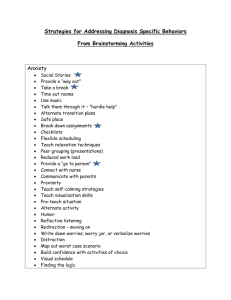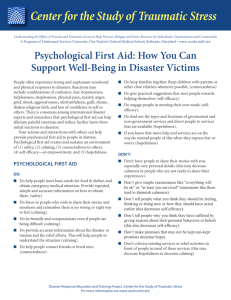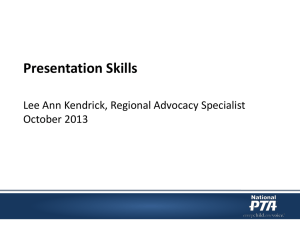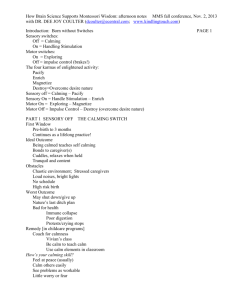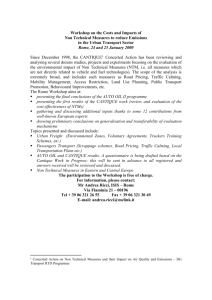POLICY Traffic Calming February 2015
advertisement
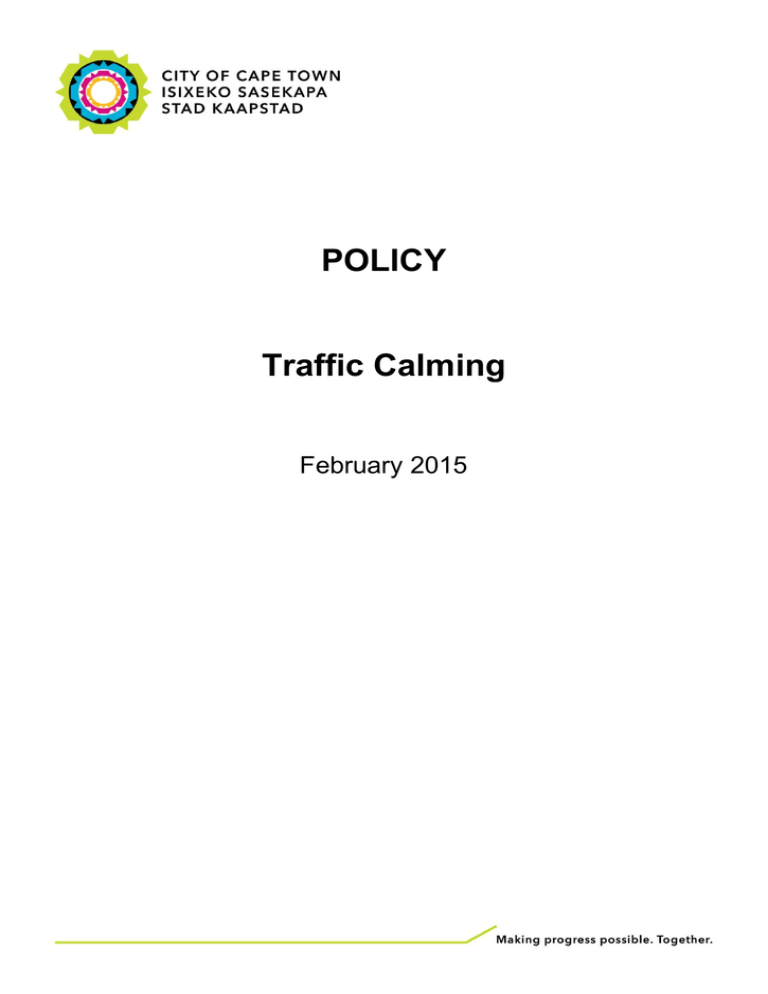
POLICY Traffic Calming February 2015 Contents 1 Problem Statement ................................................................................................................................... 1 2 Desired Outcomes .................................................................................................................................... 2 3 Strategic Intent ........................................................................................................................................... 3 4 Policy Parameters ..................................................................................................................................... 4 5 Role Players and Stakeholders ............................................................................................................. 4 6 Regulatory Context ................................................................................................................................... 5 7 Traffic Calming Policy Directives .......................................................................................................... 6 (1) Policy directives on the location of traffic calming measures ....................................................... 6 (2) Policy directives on the nature of traffic calming measures ......................................................... 7 (3) Policy directives on Transport for Cape Town’s traffic calming programme ............................. 7 (4) Policy directives on the identification of traffic calming projects by ward councillors ............... 7 (5) Policy directives on the implementation of traffic calming measures by other parties ............. 8 (6) Policy directives on public consultation ........................................................................................... 8 (7) Policy directives on the funding of traffic calming measures by the City ................................... 8 8 General Provisions ................................................................................................................................... 9 9 Implementation ........................................................................................................................................ 10 10 Monitoring, Evaluation and Review .................................................................................................... 10 Document control Policy title Draft Traffic Calming Policy for the City of Cape Town Reference code Reference Code to be provided by Executive Committee Support Services Line Department and Director Transport for Cape Town: Network Management; Mr Peter Sole Version Version 8 February 2015 Document status Draft Next review date Two years after approval Contact details Director: Network Management P Sole Tel: 021 400-4735 E-mail: peter.sole@capetown.gov.za Manager: Network Facilitation & Development S Glass Tel: 021 444-9011 E-mail: sean.glass@capetown.gov.za Definitions and Abbreviations Definitions “City” means the City of Cape Town, a municipality established by the City of Cape Town Establishment Notice No. 479 of 22 September 2000, issued in terms of the Local Government: Municipal Structures Act, 1998, or any structure or employee of the City acting in terms of delegated authority; “City of Cape Town Road Safety Strategy” means the Road Safety Strategy for the City of Cape Town approved by the Transport for Cape Town Portfolio Committee and Safety and Security Portfolio Committee in October 2013 and amended from time to time; “Class 1 Principal Arterial” means an arterial road typically 20km or more in length that provides general overall mobility to the entire metropolitan area or to important economic centres within the metropolitan area. “Class 2 Major Arterial” means an arterial road typically 10km or more in length that connects larger regions within the metropolitan area. “Class 3 Minor Arterial” means an arterial road that connects smaller districts within the metropolitan area and connects Class 2 Major Arterials with Class 4 Local Collectors. “Class 4 Collector Street” means a street with the main purpose of collecting and distributing traffic between local streets and the arterial road system. For the purposes of this policy, a Class 4 Collector Street is a collector street within a residential area, referred to as a Class 4b Residential Collector Street in the south African Road Classification and Access Management Manual (COTO, August 2012); “Class 5 Local Street” means a street with the main purpose of providing access to individual properties. For the purposes of this policy, a Class 5 Local Street is a local street within a residential area, referred to as a Class 5b Residential Local Street in the south African Road Classification and Access Management Manual (COTO, August 2012), but may also be a Class 5a Commercial Local Street (COTO, 2012) if substantial numbers of pedestrians commonly use the street; “Park” means an open public facility equipped with play equipment, walking or jogging paths or places for people to sit; “Pavement Engineering” means the design and maintenance of the surface and foundation layers of any part of a roadway; “Public Facilities” includes clinics, libraries, public halls, sports fields, swimming pools, parks, beaches, children’s homes, retirement homes, places of worship, tertiary education institutions, railway stations and pedestrian crossings over railway lines; “City of Cape Town Road Safety Strategy” means the Road Safety Strategy for the City of Cape Town approved by the Transport for Cape Town Portfolio Committee and Safety and Security Portfolio Committee in October 2013 and amended from time to time; "Road User" means any person making use of any part of a roadway; “School” includes a primary and secondary school; “Vulnerable Road User” means those road users who are most vulnerable to serious injury in the event of a crash, typically pedestrians, cyclists and the disabled. Abbreviations TCT Transport for Cape Town WCG Western Cape Government 1 Problem Statement (1) The current approach to traffic calming (a) Traffic calming is the practice of placing physical measures in a road to control the speeds at which motorists travel. The measures most often used are speed humps, raised pedestrian crossings, raised intersections and mini traffic circles. A change in the vertical or horizontal path of the vehicle regulates the maximum speed at which the vehicle can travel over the calming measure and hence along a length of road on which the measure is employed. Road markings and road narrowing are sometimes used as a soft form of traffic calming in that they do not compel a driver to slow down but attempt rather to subconsciously influence the driver’s behaviour. (b) Deterioration of driver discipline has led to increasing calls from residents for the implementation of traffic calming measures. During 2013, Transport for Cape Town (TCT) received 494 such requests from the public. For almost 20 years, local government in the Cape Town metropolitan area has seen the need for a traffic calming policy to determine which requests for calming measures should be acceded to and which should not. (c) The City of Cape Town adopted the current Traffic Calming Policy on 22 June 2011 (C08/06/11). The policy provides for automatic approval of calming measures on residential roads adjacent to public facilities and approval of measures on other residential roads subject to the satisfaction of certain criteria indicating a high potential for conflict between road users. Each and every request received from the public must be investigated by Transport for Cape Town. The Ward Councillor is also required by the policy to screen each request and indicate whether he or she supports the implementation of measures. (d) To date, implementation of the policy has been reactive. The human and financial resources available within TCT to investigate and report on traffic calming requests are inadequate to address the number of requests received. A backlog of requests has existed for several years and it is often many months before a case can be investigated. (2) Sustainability of the current approach (a) One of the aims of the City of Cape Town Road Safety Strategy is the prevention of death and injury to road users. The greatest potential for saving lives and preventing injuries in the City lies in the treatment of 1 hazardous locations on the major road network. Resources are best directed to those activities that will alter a proven and serious crash history and lead to fewer deaths and injuries in the future. The Road Safety Strategy also seeks to establish a balance in policy and resourcing between engineering, education and law enforcement interventions in road safety. (b) An overwhelming majority of deaths and injuries occur on the major road network as opposed to the residential streets on which great demands are placed for traffic calming measures. These demands have in recent years led to the allocation of substantial and costly resources to the TCT residential street traffic calming programme. The human resources available to address safety at major hazardous locations have consequently been inadequate, limiting the development of engineering interventions. In addition to the need for balance between engineering, education and enforcement interventions, an appropriate balance in the allocation of engineering resources within TCT should be established and will require a substantial reduction in the resources allocated to residential street traffic calming. (c) Due to the plethora of submissions there have been numerous assessments undertaken and projects approved. The waiting list for implementation of projects now exceeds 500 with an estimated cost of R30million – a capital allocation that has not materialized. There is therefore a need to collectively assess the 500 projects in terms of priority and relevancy criteria and then to deal with that prioritized backlog. 2 Desired Outcomes (1) The desired outcome of this policy is a sustainable programme for the provision of traffic calming measures that: (a) is aligned to the City of Cape Town Road Safety Strategy; (b) is responsive to critical road safety problems that arise from time to time on residential roads; and (c) facilitates the elimination of the backlog of approved projects within a reasonable period of time. (2) Traffic calming measures should first and foremost be provided to protect the most vulnerable road users where they occur in the largest numbers. The roads adjacent to and leading to schools should therefore be the primary 2 focus of the TCT traffic calming programme. Implementation of this Policy will ensure a systematic approach to the treatment of all schools within the metropolitan area. While TCT will implement traffic calming measures at schools within its available resources and budget, the Western Cape Government should be required to implement calming measures at all new schools as an integral part of the development of school properties. This policy objective will be put forward to the Western Cape Government in the City’s engagement with them to improve service delivery. (3) Provision should be made for ward councillors to identify, motivate and fund the implementation of traffic calming measures in response to a proven history of crashes on a road or a recent and very serious incident that demands immediate intervention. (4) Calming measures should form part of the development plans of all new public facilities implemented by the City of Cape Town and may also be implemented at existing public facilities by the relevant City departments. (5) Provision should also be made for private persons or organisations to implement traffic calming measures at their own cost, subject to the provisions of this Policy. 3 Strategic Intent (1) This Policy aligns with the IDP Pillars of the Safe City and the Caring City. Traffic calming measures on minor residential streets serve to reduce the risk of death or injury of vulnerable road users, particularly where these measures are implemented at public facilities at which large numbers of pedestrians are found. Implementation of this policy, together with effective traffic law enforcement, demonstrates the care that the City of Cape Town holds for the wellbeing of its citizens on the road network. (2) The Policy is also aligned with the City of Cape Town Road Safety Strategy. The strategy envisions a road system on which people feel safe and are safe and incorporates seven goals to improve road safety. One of these goals is Safe Road Infrastructure which is to be achieved through systematic road safety auditing, elimination of known hazardous locations on the road network and the pro-active implementation of traffic calming measures to protect the most vulnerable of road users, namely school learners. The road safety strategy therefore focussed the implementation of traffic calming by the City of Cape Town primarily on schools. This policy gives expression to the new primary focus of the City’s traffic calming programme while still providing for calming at other public facilities and hazardous locations. 3 4 Policy Parameters (1) This Policy will govern the implementation of traffic calming measures on public roads within the City of Cape Town. (2) The policy directives will determine the scope of TCT’s traffic calming programme going forward and make provision for the implementation of traffic calming measures by others. (3) Directives relating to the funding of traffic calming measures by the City of Cape Town are also specified. 5 Role Players and Stakeholders (1) Council of the City of Cape Town. The Council approves policy and monitors its implementation and makes financial decisions which affect implementation of the policy. (2) Councillors of the City of Cape Town. Councillors play key roles in communicating the policy to the public and identifying needs for road safety interventions within communities. (3) Transport for Cape Town. Transport for Cape Town takes the lead in road safety planning and implementation within the city and will be responsible for implementing this policy. (4) City of Cape Town Community Services, City Health and Human Settlements Directorates. These City of Cape Town Directorates should support the traffic calming programme by constructing traffic calming measures as integral parts of the development of new public facilities. (5) Western Cape Government Departments of Education and Transport & Public Works. These Departments of the Western Cape Government are primary stakeholders in the traffic calming programme and should support the programme by constructing traffic calming measures as an integral part of the development of new schools. (6) School management and governing bodies. The management teams and governing bodies of schools are primary stakeholders in the traffic calming programme. (7) Civil society organisations. Civil society organisations may partner with the City of Cape Town to promote road safety. 4 (8) Private property developers. Property developers may be required to implement traffic calming measures where the development is a new school or public facility. (9) Private citizens. Private citizens will benefit from the traffic calming programme. Citizens may themselves wish to fund the implementation of calming measures at public facilities. 6 Regulatory Context (1) One of the objectives of local government listed in Section 152 of the Constitution of South Africa (Act 108 of 1996) is to promote a safe and healthy environment. In terms of Section 156 of the Constitution, a municipality has executive authority in respect of, and has the right to administer the local government matters including municipal public transport, municipal roads, traffic and parking. Section 151 of the Constitution grants a municipality the right to govern, on its own initiative, the local government affairs of its community, subject to national and provincial legislation. (2) Section 11(c)(xiii) of the National Land Transport Act (Act 5 of 2009) stipulates that the municipal sphere of government is responsible for, inter alia, developing land transport policy and strategy and promoting safety and security in public transport. In the broader sense, public transport should be seen to include the use of municipal roads by members of the public. (3) Section 2(4)(b) of the Constitution of Transport for Cape Town By-Law (2013), provides for the Council and/or the Executive Mayor to confer on Transport for Cape Town the function of discharging the City’s responsibilities under the National Land Transport Act. (4) This policy also takes into account the impact of our Courts on the development of the duties and obligations of Local Government entities. There is no inherent right to require the City to implement traffic calming measures even where measures have been approved in terms of this Policy. Each instance must be judged on its own merits, taking into account the principles of lawful, reasonable and procedurally fair administrative action. 5 7 Traffic Calming Policy Directives (1) Policy directives on the location of traffic calming measures (a) In a balanced road safety system, implementation of physical traffic calming measures is limited to Class 4 Collector Streets and Class 5 Local Streets within residential areas. (b) Exceptions may be made in respect of Class 5 Local Streets within commercial areas that carry low volumes of vehicular traffic and are used or crossed by large numbers of pedestrians or cyclists. (c) On Minor Arterials (Class 3), Major Arterials (Class 2) and Principal Arterials (Class 1), which have the primary functions of mobility at reasonable speeds, the appropriate means to regulate drivers’ speeds is effective law enforcement. Physical traffic calming measures will not be used to regulate speed on these roads. (d) Traffic calming measures may, subject to the other policy directives below, be implemented on a Class 5 Local Street in a residential area in the vicinity of public facilities. Measures may take the form of a series of appropriately spaced speed humps or a combination of speed humps and raised pedestrian crossings, raised intersections, mini-circles or other calming measures that satisfy the requirements of Section 7(2) below. (e) Traffic calming measures may, subject to the other policy directives below, be implemented on a Class 5 Local Street in a commercial area that carries low volumes of vehicular traffic and is used or crossed by large numbers of vulnerable road users. Measures may take the form of a series of appropriately spaced speed humps or a combination of speed humps and raised pedestrian crossings, raised intersections, mini-circles or other calming measures that satisfy the requirements of Section 7(2) below. (f) Traffic calming measures may, subject to the other policy directives below, be implemented at intersections or locations where significant numbers of vulnerable road users cross a Class 4 Collector Street in a residential area in the vicinity of public facilities. (g) Traffic calming measures may not be implemented at locations on a Class 4 Collector Street other than those specified in Section 7(1)(f) above. 6 (2) Policy directives on the nature of traffic calming measures (a) Only those measures that are reasonably considered safe and are technically feasible and affordable may be used. (b) Determination of the technical feasibility of calming measures shall include consideration of the feasibility of installing specific measures at a given location as well as general matters such as pavement engineering and the lifecycle cost of measures. (c) Calming measures must not constitute a hazard to any road user. (d) Traffic calming measures impact negatively on the comfort of public transport users and can even lead to minor injuries to persons in public transport vehicles. It is, however, acknowledged that conflict often occurs between vulnerable road users and vehicles on public transport routes. Calming measures implemented on such routes should therefore be designed to minimize the impact on public transport users. (3) Policy directives on Transport for Cape Town’s traffic calming programme (a) TCT will focus its investigative and design resources and its capital budget firstly on providing calming measures at schools. (b) TCT will implement traffic calming measures at 50 schools per financial year, subject to available funding. (c) TCT will further implement 150 projects per financial year from the list of approved projects at the date that this Policy is approved by Council, subject to available funding. (d) Prioritization of approved projects shall consider, inter alia, the proximity of projects to public facilities and the severity of the current safety situation at the locations of projects. (4) Policy directives on the identification of traffic calming projects by ward councillors (a) Ward councillors may identify and motivate the implementation of traffic calming measures at any point on a Class 5 Local Street and at intersections or other locations where significant numbers of vulnerable road users cross a Class 4 Collector Street. 7 (b) Ward Councillors must motivate such traffic calming measures by demonstrating a proven crash history on the road in question or by identifying a recent and very serious incident on the road that demands immediate intervention and which can reasonably be prevented by traffic calming measures. (5) Policy directives on the implementation of traffic calming measures by other parties (a) It is acknowledged that significant numbers of vulnerable road users move to and from public facilities other than schools. Private individuals, companies or organisations may fund the investigation, design and implementation of calming measures at public facilities, subject to all other provisions of this policy. (b) The developers of new schools shall install traffic calming measures to the satisfaction of TCT as an integral part of the development plan for the school, subject to all other provisions of this policy. (c) The developers of new public facilities shall install traffic calming measures to the satisfaction of TCT as an integral part of the development plan for the facility subject to all other provisions of this policy. (6) Policy directives on public consultation (a) Ward Councillors and Subcouncils shall be informed of TCT’s intention to investigate, design and implement traffic calming measures within their respective areas of jurisdiction and be afforded the opportunity to comment on the proposed measures. (b) Owners of property adjacent to a road on which calming measures are proposed to be implemented shall be informed of the proposals and be afforded the opportunity to comment. (7) Policy directives on the funding of traffic calming measures by the City (a) TCT shall include an appropriate amount in its annual budget submission to implement traffic calming measures at 50 schools per financial year. (b) TCT shall include an appropriate amount in its annual budget submission to implement 150 projects per annum from the list of approved projects at the date that this Policy is approved by Council. 8 (c) Ward Councillors identifying and motivating traffic calming projects that are not funded under Section 7(7)(a) or (b) shall reserve ward allocation funding for the detailed design and implementation of such projects prior to the commencement of investigation by TCT. (d) Other directorates of the City required to implement traffic calming measures at a public facility that are not funded under Section 7(7)(a) or (b) shall provide funding to investigate, design and implement such traffic calming measures. 8 General Provisions (1) The following general provisions are made to facilitate the implementation of this policy: (a) TCT shall develop acceptable design standards for traffic calming measures on public transport routes. (b) TCT shall develop a prioritized programme for implementation of traffic calming measures at schools. (c) TCT shall develop a prioritized programme for implementation of approved projects at the time of approval of this policy, taking into account the proximity of the project to public facilities as well as the severity of current safety situation on the road. (d) TCT shall establish procedures to guide persons or bodies wishing to obtain approval for and implement traffic calming measures at public facilities. (e) TCT shall establish a written understanding with the WCG Departments of Education and Transport & Public Works to ensure that traffic calming measures are constructed at all new public schools. 9 9 Implementation (1) This policy shall be implemented from the date of approval thereof. 10 Monitoring, Evaluation and Review (1) The implementation of this policy will be monitored as an integral part of the City of Cape Town Road Safety Strategy. Progress in the implementation of the Road Safety Strategy will be reported to the Transport for Cape Town Portfolio Committee and Safety and Security Portfolio Committee every six months. (2) It is intended that the outcomes of this policy be evaluated and the policy itself be reviewed every two years. 10
